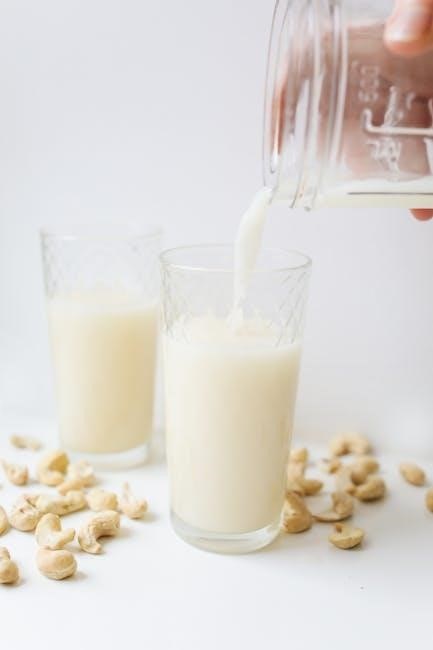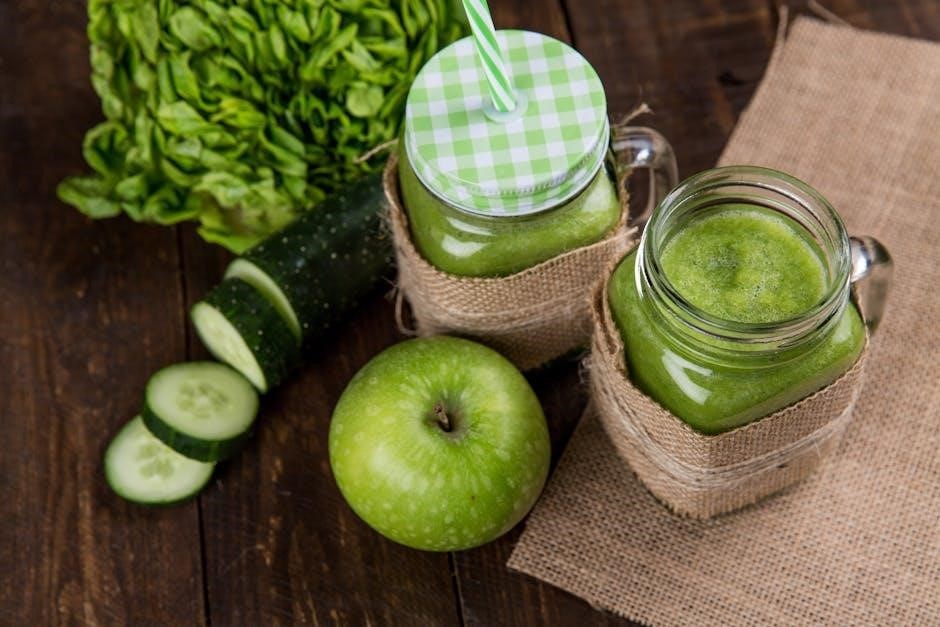Diet for Ulcers: A Comprehensive Guide
This guide explores dietary strategies for managing ulcers, drawing on current research. It emphasizes food’s crucial role alongside medication in ulcer healing and symptom relief.
Ulcers, specifically peptic ulcers, are sores that develop in the lining of the stomach, small intestine, or esophagus. Diet plays a significant role in managing ulcer symptoms and promoting healing. While it’s not the sole treatment, strategic food choices can minimize irritation, reduce acid production, and support the body’s natural repair processes. Many people mistakenly believe that ulcers are caused by stress or spicy food, but often, the bacterium Helicobacter pylori or long-term use of NSAIDs are the culprits. This section introduces the connection between ulcers and diet, setting the stage for understanding how specific food choices can aid in ulcer management. Understanding the impact of food on stomach acid levels and inflammation is key to developing an effective dietary approach.
Understanding Peptic Ulcer Disease
Peptic Ulcer Disease (PUD) involves sores that develop in the lining of the stomach, duodenum, or esophagus, occurring when stomach acid damages these protective layers. Key factors contributing to PUD include Helicobacter pylori (H. pylori) infection and the prolonged use of nonsteroidal anti-inflammatory drugs (NSAIDs). Symptoms range from abdominal pain to bloating and nausea. Understanding the underlying causes and the physiological mechanisms involved in PUD is crucial for effective management. Diagnosis typically involves endoscopy or a breath test to detect H. pylori. While medication is the primary treatment, dietary modifications play a supportive role in alleviating symptoms and promoting healing by reducing gastric acid secretion and minimizing irritation to the ulcerated areas.
The Role of Diet in Ulcer Healing
Diet plays a significant role in managing and alleviating symptoms associated with ulcers. While diet alone cannot cure ulcers, it complements medical treatment by reducing stomach acid production and preventing further irritation of the ulcerated lining. A balanced diet can promote healing by providing essential nutrients needed for tissue repair and overall digestive health. Avoiding foods that trigger acid reflux or cause stomach irritation is crucial in managing ulcer symptoms. Dietary choices can also influence the gut microbiome, potentially impacting inflammation and healing processes. A focus on easily digestible foods and regular meal patterns helps stabilize stomach acid levels, reducing discomfort and supporting the healing process. Specific foods may have protective qualities.

Foods to Include in an Ulcer Diet
Focus on incorporating foods known to soothe the stomach lining and reduce acid production. These choices can aid healing and minimize discomfort associated with ulcers.
Recommended Food Groups
For individuals managing ulcers, certain food groups are particularly beneficial. Lean proteins like fish and poultry, prepared without frying, are easily digestible. Dairy products, if tolerated, can provide essential nutrients, but monitor for any increased discomfort.
Fruits and vegetables, excluding those high in acidity (like citrus and tomatoes), offer vitamins and fiber. Cooked vegetables are generally gentler on the stomach than raw. Whole grains, such as oats and brown rice, contribute fiber but should be consumed in moderation to avoid irritation.
Probiotic-rich foods, like yogurt with active cultures, can promote gut health. Remember, individual tolerance varies, so observe how your body responds to different foods. Consulting a registered dietitian is advisable to personalize dietary recommendations.
Sample Meal Plans
Creating a structured meal plan can greatly aid in managing ulcers. A sample breakfast could include oatmeal with banana slices and a glass of milk. Lunch might consist of baked chicken breast with steamed green beans and a small portion of brown rice.
For dinner, consider baked fish with mashed sweet potatoes and cooked carrots. Snacks between meals can help stabilize stomach acid levels; options include a small bowl of yogurt or a few crackers with cheese.
Hydration is key, so drink plenty of water throughout the day. Remember to avoid trigger foods and adjust portion sizes to prevent overeating. This plan serves as a template; individual needs may require adjustments. Consulting a healthcare professional or registered dietitian can help personalize your meal plan.

Foods to Avoid with Ulcers
Certain foods exacerbate ulcer symptoms, hindering healing. These include spicy, acidic, and fatty foods, along with caffeine and alcohol, all known to irritate the stomach lining.
Foods that Irritate the Stomach Lining
Several food categories are known to irritate the stomach lining, potentially worsening ulcer symptoms and hindering the healing process. Highly acidic foods, such as citrus fruits and tomatoes, can exacerbate pain and inflammation. Spicy foods, containing capsaicin, can also irritate the stomach, leading to discomfort. Foods high in fat content can delay stomach emptying, increasing acid production and irritation.
Additionally, processed foods often contain additives and preservatives that can aggravate the stomach lining. Roughage and an abundance of fiber, such as raw vegetables and fruits with thick peels, can be difficult to digest and may cause further irritation. Therefore, identifying and avoiding these trigger foods is crucial for managing ulcers effectively. Remember that individual tolerances may vary, so careful monitoring of dietary intake is essential.
Foods that Increase Acid Production
Certain foods stimulate the stomach to produce more acid, potentially exacerbating ulcer symptoms and hindering healing. Caffeine, found in coffee, tea, and chocolate, is a significant culprit, as it can increase gastric acid secretion. Alcohol, particularly in large quantities, can also irritate the stomach lining and boost acid production. Carbonated beverages introduce gas into the stomach, leading to distension and increased acid reflux.
Additionally, mint, including peppermint and spearmint, can relax the lower esophageal sphincter, allowing stomach acid to flow back into the esophagus. High-sodium foods can also contribute to increased acid production, potentially worsening ulcer symptoms. Limiting or avoiding these foods can help reduce acid levels in the stomach, providing relief and promoting ulcer healing.

Dietary Guidelines and Tips
This section provides practical advice on preparing ulcer-friendly meals. It emphasizes the importance of eating frequency and portion control for optimal ulcer management and symptom relief.
Preparation Methods
When dealing with ulcers, how you prepare your food is nearly as important as what you eat. Opt for gentle cooking methods like steaming, boiling, or poaching. These methods help retain nutrients while minimizing irritation to the stomach lining. Avoid frying, grilling, or roasting, as these can create compounds that exacerbate ulcer symptoms.
Ensure meats are lean and tender, cutting away any visible fat. Vegetables should be cooked until soft and easily digestible. Consider pureeing or blending foods to reduce the workload on your digestive system, especially during flare-ups. Using fresh ingredients is preferable, but if using canned goods, check for low sodium content.
Seasonings should be mild; avoid excessive spices, pepper, and strong herbs that can stimulate acid production. Incorporate soothing ingredients like ginger or chamomile in your recipes. Always taste-test as you cook, ensuring the meal is gentle on the palate and stomach.
Eating Frequency and Portion Control
Managing ulcers effectively involves mindful eating habits, particularly regarding frequency and portion sizes. Instead of three large meals, aim for smaller, more frequent meals throughout the day. This approach helps to maintain a stable level of stomach acid and prevents the stomach from becoming overly full, reducing the risk of acid reflux and irritation.
Portion control is equally crucial. Overeating can lead to increased acid production and discomfort. Pay attention to your body’s signals of fullness and avoid forcing yourself to finish large portions. Use smaller plates and bowls to help regulate portion sizes. A good guideline is to eat until you are satisfied, not stuffed.
Spacing meals evenly throughout the day can also help prevent long periods of emptiness in the stomach, which can trigger acid production. A consistent eating schedule allows your digestive system to function optimally and minimizes the chances of ulcer-related symptoms.

The Importance of Medical Treatment
While diet plays a supportive role, medical treatment is paramount in ulcer management. Medications like antibiotics and acid reducers address underlying causes and promote healing.
Combining Diet with Medication
Successful ulcer treatment often involves a synergistic approach, combining dietary modifications with prescribed medications. While diet can alleviate symptoms and support healing, it is rarely sufficient as a standalone treatment, especially when Helicobacter pylori is involved.
Medications, such as proton pump inhibitors (PPIs) and antibiotics, target the underlying causes of ulcers, reducing acid production or eradicating H. pylori infection. Dietary changes complement these medications by minimizing irritation to the stomach lining and promoting an environment conducive to healing.
Following a bland diet, avoiding trigger foods, and practicing mindful eating habits can reduce discomfort and enhance the effectiveness of medical interventions. However, it is crucial to adhere to the prescribed medication regimen and consult with a healthcare professional for personalized guidance.
Remember, diet and medication work in tandem to achieve optimal ulcer management and prevent recurrence, ensuring comprehensive care and long-term relief.


